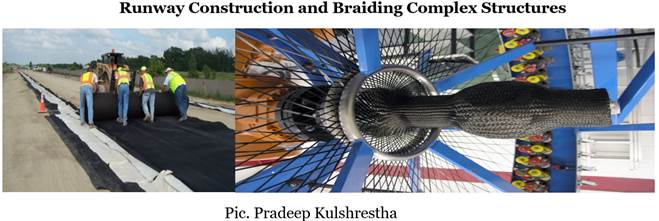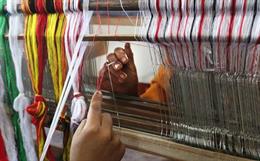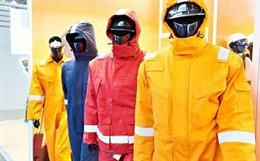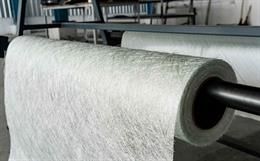Currently, one of the most significant fields of product development for engineering applications is the study of technical textiles. Textiles are able to function at an interdisciplinary level in terms of material performance because they provide a number of technical advantages that might not be found in a single typical textile material. Businesses and nations who do not grow any natural fibre crops, or that engage in very little of it, have the opportunity to create history by developing and producing synthetic textiles in an inventive manner. A lot of developing nations are becoming very interested in the field of technical textiles. Natural fibre producers are currently seeking development work in high-performance textiles for use in transportation, geoconstruction, aerospace, space shuttle, healthcare, automotive, and physical protection.
The industrialised nations, such as the United States, Western Europe, and Japan, have achieved significant advances in technical textiles via resourcefulness in innovation and improved research and technology. But Asian success stories, such as those from China and India, are also starting to matter in this area. For example, to support the technical textile industry, the Indian government approved the establishment of four centres of excellence with an allocation of ₹440 million (~5.28 million).
Fibres from textiles have been an essential component of product structure and composition over the last few decades. As material research has progressed, there is a greater focus on discovering new or creative alternatives to outperform current composites. Textile materials have been given new and exciting applications due to its lighter weight, flexibility in handling, soft touch, strength equivalent to that of metals, and ability to be modified in size and shape, all at an inexpensive price.
Consequently, a stream of creative fibre composition above and below the ground is common. Currently, textile fibres play a major role in the aviation, aerospace, medical, automotive, geo construction, transportation, and physical protection industries. Numerous textile items or components, such as the construction and design of cabins and highly specialised clothing items like space shuttle entry suits and pilot g-suits, clearly demonstrate the significant role that textile fibres play in these products.
Specific needs for safety and functional performance were brought about by variations in climatic conditions and the force of gravity during aircraft operations. It is not out of the ordinary to observe NASA’s interest in textile articles for the Mars Exploration Mission through research and development efforts. Within the technical textiles category, aerospace textiles include engineered fabrics as well as unique finished goods. It comprises textiles that have parts for certain functional needs to function in space shuttles, aeroplanes, lunar and Mars missions, and space travel. The development of technical textiles and market penetration are undoubtedly aided by the advanced technology found in Europe and the US, as well as the availability of a highly skilled and educated labour force. The percentage of textile manufacturing in these locations that falls within the category of technical textiles is close to 40 per cent.
Important Performance Features of Aerospace Textiles
-
Long-term fatigue and stress resistance
-
Resistance to chemical and organic solvents
-
Heat insulation and heat resistance
-
Fire retardancy
-
High specific modulus and tensile strength
-
Good dimensional stability and comfortability
-
UV and other harmful radiation resistance
-
Light weight and flexibility
-
Abrasion and tear resistance
-
Cut resistance
-
Hydrophobicity
-
Anti-static
Important Aerospace Textile Applications
-
Cargo netting and tie-downs
-
Seat covers & seat belts
-
Aircraft upholstery
-
Fibre-reinforced composites
-
Spacesuits
-
G-suits
-
Parachutes and controlled descent devices
-
Expandable/inflatable habitats
-
Fall-protection lifelines and lanyards
-
Various thermal insulating components
Specialty Fibres for Aerospace Textiles
Typically, highly specialised materials are used to meet the exacting performance and quality standards of the aircraft industry. They frequently consist of:
-
Meta Aramids (Nomex): It is a reasonably soft, flexible, and fire-resistant fibre.
-
Vectran: Aerospace components such as inflatable habitats and parachutes are made of high-strength, cut-resistant, chemical- and heat-resistant fibre called Vectran.
-
PBI: Spacesuits and other protective apparel are frequently made from PBI, a fire-resistant fibre that offers superior thermal protection.
-
Para Aramids: Para Aramids, also known as Kevlar, are strong, long-lasting, heat- and flame-resistant fibres that are used to make ropes, tethers, lifelines, webbing, and other aerospace components.
-
PTFE: A low-friction, heat-resistant fibre that is used to make ropes, spacesuits, and other aerospace parts.
-
Ultra-High Molecular Weight Polyethylene (Dyneema, Spectra): A remarkably robust fibre with superior hydrophobicity and resistance to cuts and abrasions.
-
Carbon Fibre: Carbon fibre is a strong, lightweight material that is used to build satellites, spacecraft, and other aerospace components.
-
Graphene: Graphene is made up of a single carbon atom and a carbon atom distribution. Graphene coating as a multipurpose material for spacecraft and aircraft structures, electrically conductive epoxy resins, and aviation electronics are a few examples of recent applications.
Boeing 787
The conventional ‘World Flight’ by Dornier from 1929 to 1949 carried 50 tons of weight, with the heavy use of the metal duraluminium and 12 Curtiss-Conqueror water-cooled piston engines consuming a lot of fuel. Cost-effectiveness and safety concepts were realised by the Boeing 787, with components initially developed in various countries. For example, the wings came from South Korea, the horizontal stabiliser and centre fuselage from Italy, the main landing gear wheel from Japan, the landing gear from England, and the passenger entry doors from France, among others.
According to Boeing, the improved features include:
Windows in the 787 are 65 per cent larger, and there are no mechanical shades. Instead, individual passengers can adjust the window next to their seat from fully transparent to completely dark.
Overhead storage bins are larger, making it less likely that passengers will have to store things under the seat in front of them.
A better air-filtration system with a gas filtration system removes odours and contaminants that can cause nose, throat, and eye irritation.
Because the fuselage is constructed mainly of composite materials (instead of aluminium), the cabin can be pressurised to a lower altitude – 6,000 feet instead of 8,000 feet. This reduces the likelihood of discomfort and fatigue.
Airline cabin air typically is very dry to prevent corrosion in the aluminium airframe. The non-corroding composite material in the 787 means cabin air can have a higher level of humidity, which is more comfortable for passengers.

Applications
-
The g-suit is an intriguing textile product that is very helpful in aircraft operations. This particular type of clothing usually takes the shape of formfitting trousers. Pilots wear it to regulate their blood circulation when they accelerate at higher speeds. Pilots can accomplish their desired functions because the g-suit is made to decrease blood flow to the lower body when accelerating or decelerating. A g-suit typically consists of inflatable bladders filled with liquid or air that can be compressed with the help of a g-sensitive valve and kept firmly in place around the legs and abdomen at higher g values. Because it is used to deal with accelerated motion against gravity, it is also known as an antigravity suit.
-
Rapid changes in acceleration have a physical impact on the fighter pilot that affects how his body moves. A pilot weighing 160 pounds can usually feel a nine-fold increase in weight in a matter of seconds, reaching 1440 pounds or more. Another fascinating aspect of tiles’ role in space operations is their suitability for astronauts. Spacesuits are the general term for the clothes used in spacecrafts. The engineered textile clothing was utilised in space exploration missions for study. For example, NASA had been an important user of spacesuit pressure garment. Early in the 1960s, astronauts were able to walk on the lunar surface due to the Apollo A7LB, the first highly mobile spacesuit.
-
The invention of the parachute is a more inventive discovery. It has made a major contribution to the safe and reliable aero-transport of goods up to this point. It is interesting to note that the first parachuting demonstration activity used a dog as a passenger. Linen stretched over a wooden frame served as the textile component. Later, silk was employed due to its strength and light weight. The history of the parachute dates back to the ninth century, but the modern parachute may have originated in France in the eighteenth century (1783).
-
Typically, a parachute is made up of suspension lines, supporting tapes, and thin, lightweight fabric. Parachutes can be made from fabric made of nylon, polyester, Kevlar, or Nomex fibres. The Kevlar tethers attach the parachute to the back shell. The fibres, such as Kevlar and Nomex types, exhibit significant physical properties. As an illustration, consider the strength of Kevlar fibres, which is five times higher than steel when considering equal weight. When producing engineered textiles, the toughness and high rigidity are helpful because they provide the desired resistance to shock and cuts. In aerospace operations, the weather resistance and flexibility of fibres offer intriguing features to achieve.
-
In developing the parachute design, consideration is given to the forces operating on the parachute after it has fully expanded. Usually, the atmospheric density, velocity, mass, and parachute drag area can be used to compute these forces.
-
The only gear that really help with aerospace operations are parachutes, spacesuits, and anti-gravity suits. There are, however, a number of others, and more ideas exist. Additional instances are the textile products that are utilised as the basic material of aircrafts and are recognised to greatly enhance the style, design, and construction. These elements have historically included sheepskins, wall coverings, curtains, and upholstery materials. The objects can be tailored for comfort and design, and they can also be made flame-resistant to meet safety regulations. The performance needed in specialised applications is now widely acknowledged for textile fibres.
-
Specialty narrow fabrics are now a crucial part of many applications in aerospace, space exploration, and contemporary aircraft design, such as electrical conductivity, fight gear, thermal insulation, cargo containment, structural reinforcement, and expandable space habitats. High-performance materials like Kevlar, Nomex, Spectra/Dyneema (UHMWPE), and Vectran are commonly used to make these because of their strength, durability, and ability to withstand harsh temperatures and other environmental conditions.
Spacesuit
In practical terms, the spacesuit is referred to as a ‘One Person Spacecraft’ in addition to being a set of clothes. It is a suit worn to protect a person from the extreme vacuum and temperature changes that come with living in space. In the event of a loss of cabin pressure, spacesuits are frequently worn inside spacecraft as a safety measure. They are also required for extravehicular activity (EVA), or work performed outside the spacecraft. For this kind of work, spacesuits have been worn in Earth orbit, on the moon, and on the way back to Earth from space.
In order to keep the wearer comfortable and reduce the amount of effort needed to bend their limbs, modern spacesuits add sophisticated equipment and environmental controls to the basic pressure garment. This prevents the soft pressure garment from naturally stiffening against the hoover. To enable total mobility, independent of the spacecraft, a self-contained oxygen supply and environmental control system are commonly used. To achieve all these demanding performance objectives, a modern spacesuit must have a multitude of textile components made of different materials. IVA (intravehicular activity), EVA (extravehicular activity), and IEVA (intra/extravehicular activity) are the three categories of spacesuits that are available for various uses. IVA suits are more comfortable and lighter because they are designed to be worn inside pressurised spacecraft. IEVA suits are designed to be used both within and outside of spaceships. They offer increased defence against the hostile environment of space, including defence against micrometeoroids and drastic temperature changes. EVA suits are used for spacewalks or planetary exploration outside of spacecraft. They must offer mobility and functionality, as well as protection against all space-related hazards, to the wearer.
Pressure suits used for other specialised tasks, like high-altitude reconnaissance flight, must also meet some of these requirements. It is necessary to wear pressurised suits because water boils at body temperature at elevations above the Armstrong limit, or about 19,000 m (62,000 ft).
Carbon & Glass Fabric Applications in Aerospace
Carbon is used for the fuselage of aircraft as UD (unidirectional) weave to maintain strength through warp. Blackout curtains used for Dreamliner planes are made with e-glass. On the front streamlined portion, carbon satin fabric is used. The flaps, engine, and wheels gain strength from Aramid and Dyneema fabric in various weaves.
Carbon Product Variants & Applications
|
Product Variance |
Applications |
|
Carbon Fibre |
Automotive / Aircraft |
|
Carbon Roving |
Aircrafts |
|
Carbon Fabric |
Aircraft / Space Antenna |
|
Chopped Carbon Fibres |
Infrastructure |
|
Carbon Hybrid Fabrics |
Fuselage of Aircraft |
|
Carbon / Cabler |
Engine of Aircraft |
Conclusion
Textiles are ubiquitous in aircraft, from pilot apparel to the aircraft itself. The technical textiles sector, encompassing engineered textiles and unique finished products, is known as aerospace textile. This sector includes textiles designed for specific functional needs in spacesuits, shuttles, aircraft, lunar and Mars missions, and space travel. It focuses on the development of composites for aerospace and inflatable coated structures using advanced materials. Satellite-based personal communication systems (SPCS) utilise the satellite network to connect mobile personnel on the ground via a central support network in both military and disaster management situations. To maintain portability, these systems require lightweight equipment that can be quickly and easily deployed and operated in various environments. Composites are used for structural applications and components in aircraft and spacecraft, including inflatable antennas for space. The focus is on glass, carbon, aramid, and Dyneema based on research and development and their manufacturing methods. Development of high-strength core and sheath ropes and belts using weaving and braiding technologies is ongoing. Research aims to use nanoweb technology for the protection, hygiene, and health of human life. A good filtration property is an added advantage in developing products with nanotechnology at the cutting edge of design that is sweeping the world.
Braiding is popular for manufacturing industrial ropes, fabrics, and structures for composite applications. The braiding process is classified as two-dimensional and three-dimensional. A special advantage of three-dimensional braiding is their ability to develop a variety of symmetrical and non-symmetrical complex shapes without the need for cutting, joints, and splices. There is a demand for Leno fabric for railway tracks with PVC coating. For bridge construction, woven fabric is used, while for heavy vehicles with high speed, knitted fabrics with coating meet the long-term application requirements. Pultrusion is a low-cost method of making high stiffness hollow sections of composites. The advantages of pultruded composite profiles in applications include their lightweight, high strength, resistance to corrosion, and fast, easy installation.
- Anon., Markets for technical textiles, Business Coordination House, Home page, www.bch.in, accessed June 24, 2008
- Seshadri Ramkumar; Appachi Arunachalam, India rising: Opportunities in nonwovens and technical textiles, Texas technical university, Texas (USA), pp1- 2.
- Reena Mital, Technical textile net, Home page, www.technical-textiles.net, accessed July 3, 2008.
- Ed., Faheem Uddin, BE textile design project, NED university of engineering and technology, 2005.
- Anon., G- suit, Home page, http://en.wikipedia.org, accessed June 26, 2008.
- Anon., Antigravity suit, The internet encyclopaedia of science, Home page, www.daviddarling.info, accessed June 26, 2008.
- Anon., Space Suits, ILC Dover, Home page, www.ilcdover.com
- Anon., Parachute- Wikipedia, Home page, http://en.wikipedia.org, accessed July 2, 2008.
- Anon., Jet propulsion laboratory, Mars exploration rover mission, Home page, http://marsrovers.jpl.nasa.gov, accessed July 2, 2008.
- Anon., Lantal textiles, Home page www.aerospace-technology.com.
- Specialty Narrow Fabrics for Aerospace and Space Travel: OTEX

_Big.jpg)





